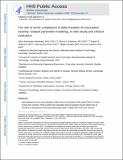| dc.contributor.author | Motamed, Payam K. | |
| dc.contributor.author | Garcia, Julio | |
| dc.contributor.author | Dahdah, Nagib | |
| dc.contributor.author | Kadem, Lyes | |
| dc.contributor.author | Keshavarz Motamed, Zahra | |
| dc.contributor.author | Edelman, Elazer R | |
| dc.date.accessioned | 2017-05-08T14:07:23Z | |
| dc.date.available | 2017-05-08T14:07:23Z | |
| dc.date.issued | 2015-10 | |
| dc.date.submitted | 2015-10 | |
| dc.identifier.issn | 0021-9290 | |
| dc.identifier.uri | http://hdl.handle.net/1721.1/108732 | |
| dc.description.abstract | Early detection and accurate estimation of the extent of coarctation of the aorta (COA) is critical to long-term outcome. Peak-to-peak trans-coarctation pressure gradient (PKdP) higher than 20 mmHg is an indication for interventional/surgical repair. Patients with COA have reduced proximal and distal aortic compliances. A comprehensive study investigating the effects of variations of proximal COA and systemic compliances on PKdP, and consequently on the COA severity evaluation has never been done. This study evaluates the effect of aortic compliance on diagnostic accuracy of PKdP. Lumped parameter modeling and in vitro experiments were performed for COA severities of 50%, 75% and 90% by area. Modeling and in vitro results were validated against retrospective clinical data of PKdP, measured in 54 patients with COA. Modeling and in vitro. PKdP increases with reduced proximal COA compliance (+36%, +38% and +53% for COA severities of 50%, 75% and 90%, respectively; p<0.05), but decreases with reduced systemic compliance (−62%, −41% and −36% for COA severities of 50%, 75% and 90%, respectively; p<0.01). Clinical study. PKdP has a modest correlation with COA severity (R=0.29). The main determinants of PKdP are COA severity, stroke volume index and systemic compliance. Systemic compliance was found to be as influential as COA severity in PKdP determination (R=0.30 vs. R =0.34). In conclusion, PKdP is highly influenced by both stroke volume index and arterial compliance. Low values of PKdP cannot be used to exclude the severe COA presence since COA severity may be masked by reduced systemic compliance and/or low flow conditions. | en_US |
| dc.language.iso | en_US | |
| dc.publisher | Elsevier | en_US |
| dc.relation.isversionof | http://dx.doi.org/10.1016/j.jbiomech.2015.10.017 | en_US |
| dc.rights | Creative Commons Attribution-NonCommercial-NoDerivs License | en_US |
| dc.rights.uri | http://creativecommons.org/licenses/by-nc-nd/4.0/ | en_US |
| dc.source | PMC | en_US |
| dc.title | The role of aortic compliance in determination of coarctation severity: Lumped parameter modeling, in vitro study and clinical evaluation | en_US |
| dc.type | Article | en_US |
| dc.identifier.citation | Keshavarz-Motamed, Zahra; Edelman, Elazer R.; Motamed, Payam K.; Garcia, Julio; Dahdah, Nagib and Kadem, Lyes. “The Role of Aortic Compliance in Determination of Coarctation Severity: Lumped Parameter Modeling, in Vitro Study and Clinical Evaluation.” Journal of Biomechanics 48, no. 16 (December 2015): 4229–4237. © 2015 Elsevier Ltd | en_US |
| dc.contributor.department | Institute for Medical Engineering and Science | en_US |
| dc.contributor.department | Harvard University--MIT Division of Health Sciences and Technology | en_US |
| dc.contributor.mitauthor | Keshavarz Motamed, Zahra | |
| dc.contributor.mitauthor | Edelman, Elazer R | |
| dc.relation.journal | Journal of Biomechanics | en_US |
| dc.eprint.version | Author's final manuscript | en_US |
| dc.type.uri | http://purl.org/eprint/type/JournalArticle | en_US |
| eprint.status | http://purl.org/eprint/status/PeerReviewed | en_US |
| dspace.orderedauthors | Keshavarz-Motamed, Zahra; Edelman, Elazer R.; Motamed, Payam K.; Garcia, Julio; Dahdah, Nagib; Kadem, Lyes | en_US |
| dspace.embargo.terms | N | en_US |
| dc.identifier.orcid | https://orcid.org/0000-0001-5853-3887 | |
| dc.identifier.orcid | https://orcid.org/0000-0002-7832-7156 | |
| mit.license | PUBLISHER_CC | en_US |
| mit.metadata.status | Complete | |
